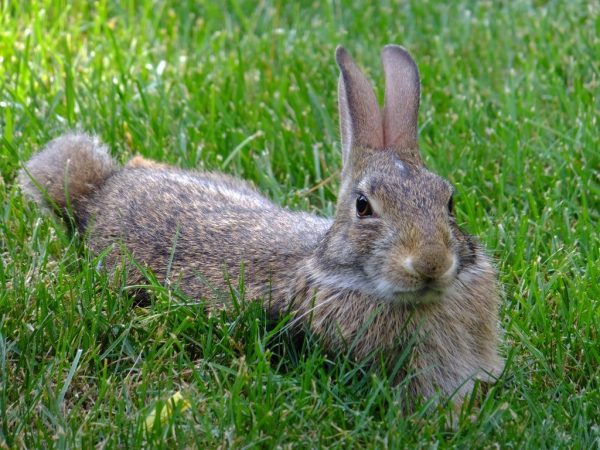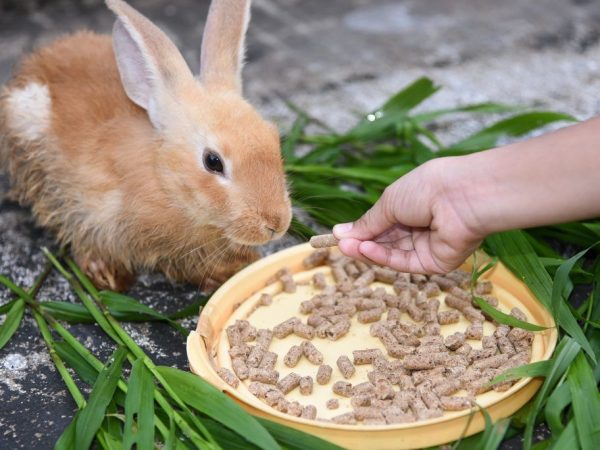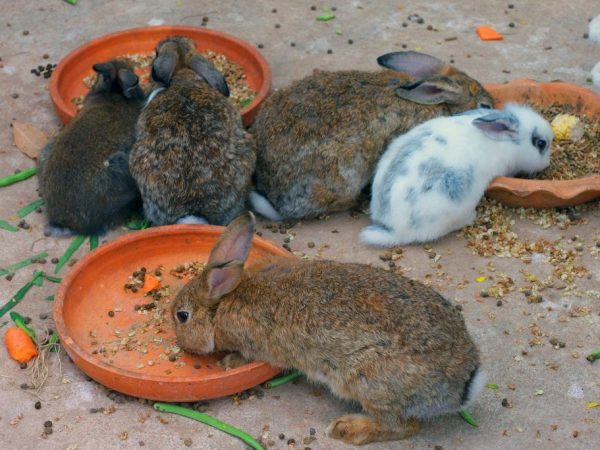How to feed rabbits for meat at home
Rabbits can really be bred at home: pets do not require complex care. However, feeding rabbits for meat is not so simple: the animal's diet consists of 4 types of feed, and for a good quality product, the eared menu must be balanced.

Fattening rabbits for meat
These animals serve as a source of quality wool and nutritious meat, they are unpretentious in food and reproduce well.
Rabbit meat breeds
There are many breeds of rabbits, depending on the purpose of the final product. Some types are suitable for the sale of wool, others are for meat. Decorative breeds are bred exclusively as pets.
Large breeds of rabbits are suitable for fattening, such as:
- New Zealand and California;
- Gray Giant;
- Soviet Chinchilla;
- Flandre (Belgian giant).
Most often, New Zealand and California rabbit breeds are used for breeding for meat. Their feature is fast weight gain. These eared eared are fattened by the third month of life and allowed to be slaughtered, therefore the breed is valued by farmers for its high profitability. The percentage of meat in the New Zealand breed is extremely high in relation to the weight of the animal, and the taste is considered one of the best. This breed comes from the USA, and rabbit breeders fought over the removal of all positive qualities for more than one year. The mass of rabbits in the 3rd month of life reaches 5 kg. The pure meat yield of these rabbits is about 55%.
Rabbits gain weight quickly: by the second month of life, their weight reaches 2 kg. The meat of the cubs is especially tender, but it is not rational to let them go to slaughter. One of the features of these pets is their thick paws, thanks to which they can live in cages with a mesh floor.
The California type of rabbit is a younger breed, bred for fattening. The size of adults is inferior to New Zealand rabbits. The weight of pets varies from 3 to 4 kg. Rabbits gain up to 2 kg within 2 months. California rabbits are tightly knit and dense, so the yield of pure meat is 60%.
Among the breeds common in the CIS countries, the Gray Giant occupies a special place. These rabbits reach a weight of 6-7 kg, and the female brings up to 10 cubs at a time. Due to these features, this type of rabbit is widely used on farms, but the taste of the Giant is significantly inferior to American breeds.
Breeding for slaughter is accompanied by a number of rules for feeding at home. Without special fattening, the farm will not only be left without profit, but will not even recoup the costs of keeping the eared ones.
Feeding rabbits for weight gain
In order for the rabbit to bring the right amount of meat, they begin to feed it at about 2-3 months. By this time, the stomach of the rabbits is already fully formed. Also, rejected individuals unsuitable for reproduction are allowed for slaughter.Approximately 40% of the herd is slaughtered for sale annually.
To increase weight and improve the palatability of the meat, rabbits are fattened for about a month before slaughter. The duration of such feeding depends on the available parameters of the furry and its age. Young animals gain weight faster than adults. The diet changes depending on the feeding stage.
There are 3 stages of rabbit feeding:
- preparatory (choice of diet);
- basic (rapid weight gain in an animal);
- final (weight and fat correction).
During the preparatory phase, the rabbit should receive the maximum calorie food. The amount of greens and succulent feed remains unchanged, while the rate of concentrated feed is increased by 50%. Winter fattening takes place with a minimum consumption of hay and branch feed. However, it is necessary to monitor the level of vitamins in the animal's body: weak immunity leads to disease.

Rabbit feeding rules
The best products during the preparatory phase are compound feed, corn, oats, barley, wheat and wheat bread, legumes. The preparatory stage lasts no more than 5 days.
The second stage of fattening is aimed at the formation of a fat layer in pets. To do this, you need to feed the rabbits with foods that contain a high concentration of fats: boiled potatoes, flax and hemp seeds, cake. Root crops and hay should be given very sparingly. Ordinary cereals cooked in water with the addition of whole milk also contribute to the accumulation of fat. At this stage, you need to constantly monitor the rabbits, since their gastrointestinal tract is a weak point. If you exceed the permissible amount of fat per day, the rabbit will rip the stomach. The main period lasts about a week.
During the final period, special attention is paid to the appetite of the eared. The rabbit should eat all the food that is given to him per day. To increase the appetite of pets, dill, caraway seeds, celery are added to their food, or water is salted. At the last stage, it is forbidden to give hay and greens, and the rate of the combined feed is brought to the maximum. If the rabbit is allowed to eat grass before slaughter, the meat will be tougher.
The fattening of meat breeds should be taken seriously: the quantity and quality of meat depends on it. With an unbalanced diet, young rabbits develop problems with the gastrointestinal tract. Feeding preparation starts a few days before the first stage. At first, the cubs are fed light foods rich in vitamins. The compound feed is finely crushed and mixed with the crushed boiled potatoes. It is imperative to observe the rate of salt and bone meal in the animal's diet, otherwise they will have serious bone problems.
Methods for breeding rabbits for meat
The way of feeding rabbits plays no less role than a properly balanced diet of eared ones. Meat acquires the best taste at 6-7 months of the rabbit's life.
But there are different ways to achieve this. Improving taste is also corrected by special foods in the rabbit's diet.
Broiler method of breeding rabbits
This is a common method used on large farms. For broiler breeding, meat rabbits are not separated from the mother until slaughter. Due to the nutritional value of milk, rabbits quickly gain weight, and the rabbit, in the meantime, is sent back to mate.
The main advantage of this method is saving on cells.
At the same time, such intensive feeding greatly depletes the rabbits, therefore it is recommended to give them an increased amount of compound feed, otherwise the females' immunity is weakened, milk disappears and the reproductive system is disturbed. Also, from frequent feeding and non-compliance with sanitary standards for keeping rabbits, diseases of the mammary glands develop.

Broiler breeding of meat rabbits
The skin of broiler rabbits has a low value, but the meat is nutritious and has a high taste.For this breeding method, meat breeds such as the White Giant, the Silver Crab and the Soviet Chinchilla are used. These types of rabbits are particularly early maturing and quickly gain weight due to the female's milk. Usually the weight at the end of 6 weeks of these rabbits already reaches 2-3 kg.
Concentrated feed in the diet of a rabbit during lactation should be at least 50% in summer and up to 60% in winter. Rabbits will grow faster if they receive about 150 g of protein per feed unit. Hay is used from dried legume shoots, they also contain vitamins, but the nutritional value is much higher. Broiler pets can be given any amount of water.
Common method for feeding young rabbits
When using conventional fattening, young rabbits for slaughter should be removed from the female in the second month. The diet should also consist mainly of concentrated feed. The first 10 days after jigging, the eared should receive 450 g of legumes and 45 g of pure grain.
In parallel with this, the animal can be fed with a balanced compound feed. Within 2 months, these values increase by 1.5 times, and by 3 months - 2. By the age of six months, the rabbit is already allowed to be slaughtered. Usually fattening meat does not have the same high taste as broiler meat, however, wool is an order of magnitude better and can bring some profit.

Feeding young rabbits
On large farms over 200 heads, both methods are used in parallel. This allows the females to be relieved of the burden and to obtain equally high quality meat and good skins for sale. Medium-sized holdings of up to 200 animals per herd alternate these feeding methods for young rabbits to give the females time to recover. With a herd of less than 100 rabbits, the usual method of feeding is used, and broiler feeding is used no more than 2 times a year.
Increasing the mass of rabbits in additional ways
Experienced rabbit breeders use some methods that can affect the growth of the animal's weight. The most well-known factors contributing to weight gain are:
- Correct grouping of animals. There are always weak and strong individuals among the herd. It is necessary to cage animals based on these indicators. Then the rabbits will receive food in equal shares, and no one will be left hungry.
- Limited space. Rabbits are active animals, but during feeding, you can restrict their movement. This will help rabbits gain weight quickly, thanks to the law of conservation of energy.
- The feeder for rabbits selected for fattening should not be empty. These animals should be fed 4-5 times a day.
Rabbits are nocturnal animals, so very often breeders darken the cage at home, increasing their appetite. So the fluffy eats more often, which means that the weight gain increases several times.
At the same time, you should not keep the animal in semi-darkness all the time: this will affect its well-being not in the best way.
Food supplements for artificial mass gain
It is widely believed among experienced farmers that rabbits can be given certain vitamins to increase their appetite. If you do not take into account the unscrupulous rabbit breeders who feed animals with dangerous chemicals for quick fattening, this practice is considered correct. Regular vitamins can be added to the animal's water or mixed with wet bran.
Vitamins A and E are dissolved in fats, vitamin D, which is contained in fish oil, is given in cereals. To increase vitamin C in the body, water is usually acidified.
Also, in the correct proportions and with the consent of the veterinary specialist, the eared ones are soldered with premixes (vitamin and mineral supplements) and BVMD (protein-vitamin-mineral supplements). Premixes contain not only the necessary complex of vitamins, but also elements such as calcium, manganese, phosphorus. They strengthen the body of the animal.In addition to the usual useful things, the BVMD also includes protein components, thanks to which more protein gets into the rabbit's body.
Vitamin-complex supplements should not be confused with steroids or aggressive chemicals: the former are legal and affect only the absorption of feed by the body. Premixes do not impair the taste of meat and do not have destructive consequences for the human body. These components help the rabbit to get the maximum amount of nutrients from the feed, due to which the eared ears gain mass faster. The calculation of the dose of vitamin supplements depends on parameters such as the weight and age of the animal. Do not abuse them: the increased amount of iron and magnesium in the blood will spoil the taste of rabbit meat.
Summarizing
Fattening of farm rabbits has recently become more and more popular all over the world. The meat of these pussies is valued primarily for its nutritional value and dietary quality; it is recommended for people with congenital heart and kidney defects.
In the wild, rabbits feed on plant foods, but there are various ways to feed these animals to improve the palatability of meat on farms. Most often, the broiler feeding method is used, but for small farms, the usual one is sufficient.


